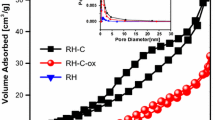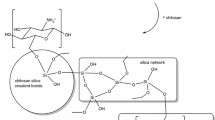Abstract
This study reports the development of a functional adsorbent synthesized by the molecular imprinting method in a sol–gel matrix. The adsorption capacity of the organic-inorganic hybrid adsorbent material was tested on tannin compounds, i.e., phenolic substances that are among the most difficult compounds to remove in industrial wastewater. The specific surface area obtained by nitrogen porosimetry analysis was between 2 and 579 m2 g−1 due to each sol–gel synthetic route used. Small-angle X-ray scattering analysis revealed that the hybrid silicas were arranged in a multi-level structure consisting of three levels of organization and a surface fractal structure. Diffuse reflectance spectroscopy revealed the interactions between the tannins and the silica matrix, and confirmed the partial removal of tannins after ultrasound-assisted extraction. Zeta potential analysis showed that the values ranged between −37.9 and +27.8 mV, where non-functionalized xerogels were anionic and those functionalized with organosilane were cationic. The structural and textural characteristics of the hybrid materials were found to depend on the sol–gel synthetic route, which in turn affected the adsorption capacity. The adsorbent functionalized with (3-Aminopropyl) triethoxysilane was an effective adsorbent for the tannin compounds tested here, with approximately 90% removal in aqueous solutions.
Graphical abstract









Similar content being viewed by others
References
Gutterres M, Aquim PM de (2013) Wastewater reuse focused on industrial applications. Wastewater Reuse Manag. p 127–164
Kickelbick G (2007) Hybrid materials: synthesis, characterization, and applications. Wiley-VCH, Weinheim
Schubert U, Hüsing N (2005) Synthesis of inorganic materials. Wiley-VCH, Weinheim
Ciriminna R, Sciortino M, Alonzo G et al. (2011) From molecules to systems: sol-gel microencapsulation in silica-based materials. Chem Rev 111:765–789. https://doi.org/10.1021/cr100161x
Samiey B, Cheng C-H, Wu J (2014) Organic-inorganic hybrid polymers as adsorbents for removal of heavy metal ions from solutions: a review. Mater (Basel) 7:673–726. https://doi.org/10.3390/ma7020673
Sun C, Zhang C, Li C et al. (2015) Syntheses of polyamine-bridged polysilsesquioxanes hybrid materials combining sol–gel processing and molecular imprinting applied to selective adsorption for copper. Mater Chem Phys 153:307–315. https://doi.org/10.1016/j.matchemphys.2015.01.018
Wei S, Hu X, Liu H et al. (2015) Rapid degradation of Congo red by molecularly imprinted polypyrrole-coated magnetic TiO2 nanoparticles in dark at ambient conditions. J Hazard Mater 294:168–76. https://doi.org/10.1016/j.jhazmat.2015.03.067
Ramström O, Mosbach K (1999) Synthesis and catalysis by molecularly imprinted materials. Curr Opin Chem Biol 3:759–764. https://doi.org/10.1016/S1367-5931(99)00037-X
Jin G, Zhang B, Tang Y et al. (2011) Imprinted functionalized silica sol-gel for solid-phase extraction of triazolamin. Talanta 84:644–650. https://doi.org/10.1016/j.talanta.2011.01.035
Morais EC, Correa GG, Brambilla R et al. (2012) Silica imprinted materials containing pharmaceuticals as a template: textural aspects. J Solgel Sci Technol 64:324–334
Kanagaraj J, Senthilvelan T, Panda RC, Kavitha S (2015) Eco-friendly waste management strategies for greener environment towards sustainable development in leather industry: a comprehensive review. J Clean Prod 89:1–17. https://doi.org/10.1016/j.jclepro.2014.11.013
Guieysse B, Norvill ZN (2014) Sequential chemical-biological processes for the treatment of industrial wastewaters: review of recent progresses and critical assessment. J Hazard Mater 267:142–52. https://doi.org/10.1016/j.jhazmat.2013.12.016
Dixit S, Yadav A, Dwivedi PD, Das M (2015) Toxic hazards of leather industry and technologies to combat threat: a review. J Clean Prod 87:39–49. https://doi.org/10.1016/j.jclepro.2014.10.017
Ilavsky J, Jemian PR (2009) Irena: tool suite for modeling and analysis of small-angle scattering. J Appl Crystallogr 42:347–353
Kline SR (2006) Reduction and analysis of SANS and USANS data using IGOR Pro. JCR. J Appl Crystallogr 39:895–900
Dieudonné P, Alaoui AH, Delord P, Phalippou J (2000) Transformation of nanostructure of silica gels during drying. J Non Cryst Solids 262:155–161. https://doi.org/10.1016/S0022-3093(99)00687-0
Pujari PK, Sen D, Amarendra G et al. (2007) Study of pore structure in grafted polymer membranes using slow positron beam and small-angle X-ray scattering techniques. Nucl Instrum Methods Phys Res B 254:278–282. https://doi.org/10.1016/j.nimb.2006.11.052
Hunter RJ (1981) Zeta potential in colloid science: principles and applications. Academic Press, London; New York, NY
Sing KSW (1985) Reporting physisorption data for gas/solid systems with special reference to the determination of surface area and porosity (Recommendations 1984). Pure Appl Chem 57:603–619
Hench LL, West JK (1990) The sol-gel process. Chem Rev 90:33–72. https://doi.org/10.1021/cr00099a003
Wang J, Ji Y, Ding S et al. (2013) Adsorption and desorption behavior of tannic acid in aqueous solution on polyaniline adsorbent. Chin J Chem Eng 21:594–599. https://doi.org/10.1016/S1004-9541(13)60516-9
Wang J, Li A, Xu L, Zhou Y (2009) Adsorption of tannic and gallic acids on a new polymeric adsorbent and the effect of Cu(II) on their removal. J Hazard Mater 169:794–800. https://doi.org/10.1016/j.jhazmat.2009.04.013
Rappoport Z, Apeloig Y (1998) The Chemistry of organic silicon compounds. 2nd ed Wiley, Chichester
Vansant EF, Van Der Voort P, Vrancken KC (1995) Characterization and chemical modification of the silica surface. Stud Surf Sci Catal. https://doi.org/10.1016/S0167-2991(06)81528-4
V.M. G, S.T. M, S.V. M et al. (2011) Comparative characterization of carbon adsorbents and polymer precursors by small-angle X-ray scattering and nitrogen adsorption methods. J Phys Chem C J Phys Chem C 115:10727–10735
Rahman IA, Jafarzadeh M, Sipaut CS (2009) Synthesis of organo-functionalized nanosilica via a co-condensation modification using γ-aminopropyltriethoxysilane (APTES). Ceram Int 35:1883–1888. https://doi.org/10.1016/j.ceramint.2008.10.028
Acknowledgements
J. Benvenuti is grateful for the grant provided by CAPES. The authors wish to thank LNLS (Project D11A-SAXS1-8691) for the SAXS beamline measurements.
Author information
Authors and Affiliations
Corresponding authors
Ethics declarations
Conflict of interest
The authors declare that they have no conflict of interest.
Rights and permissions
About this article
Cite this article
Benvenuti, J., Capeletti, L.B., Gutterres, M. et al. Hybrid sol–gel silica adsorbent materials synthesized by molecular imprinting for tannin removal. J Sol-Gel Sci Technol 85, 446–457 (2018). https://doi.org/10.1007/s10971-017-4564-z
Received:
Accepted:
Published:
Issue Date:
DOI: https://doi.org/10.1007/s10971-017-4564-z




